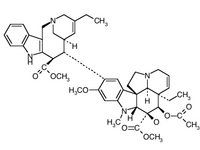INTRODUCTION: Vinorelbine (Navalbine), a newer Vinca alkaloid has been increasingly used in the chemotherapy of non-small-cell Bronchogenic carcinoma & metastatic breast carcinoma. Initially, it appeared to have a favorable side-effect profile with dose & duration limited myelo-suppression (Granulocytopenia, Thrombocytopenia) being the major toxicityl. With more frequent use of Vinorelbine, new side effects of this drug are being reported. We are reporting a case of Interstitial Pneumonitis developing after Vinorelbine therapy for Bronchoalveolar carcinoma.
CASE PRESENTATION: K.K. 46 year old farmer smoker presented to our OPD with complaints of dull diffuse chest pain on right side, cough with mucoid expectoration >200 ml/d & breathlessness. On physical examination breath sounds were diminished in intensity on right side, coarse crept was present in mid & lower chest. Chest X-Ray revealed diffuse heterogenous infiltrates with air-bronchogram in right lung. Patient was previously treated for bronchopneumonia with broad-spectrum antibiotics elsewhere but had no improvement. Considering the possibility of malignancy, Fibre-Optic Bronchoscopy revealed excessive mucoid secretions. Bronchial-brush and Bronchoscopic-lavage was negative for microbiology & cytology, so lung biopsy was done, it showed bronchoalveolar carcinoma. CT-scan chest revealed, focal area of apparent parenchymal consolidation with linear strands extending to the periphery. After complete evaluation & basic investigation {Complete Blood Count (CBC), Liver Function Test, Renal Function Test} we planned chemotherapy with Vinorelbine, hence Vinorelbine 50 mg (as the body surface area was 1.68m2) over 10 minutes was infused after proper hydration, patient tolerated the drug well & after observation for 1 day, he was discharged on request. After 3 days, patient returned with complaints of increasing dyspnoea, dry cough & severe distress. He was tachycardiac, accessory muscles of respiration was working, breath sounds were diminished and of bronchial nature on right side, Chest X-Ray revealed extensive consolidation on whole of right lung. His CBC was normal & sputum for Gram stain/culture was negative. However because of suspicion of community-acquired-pneumonia, broad-spectrum antibiotic & intravenous steroids were started, patient responded well with clearance of radiological-infiltrates. Next week, IInd cycle of Vinorelhine 50 mg over 10 minutes was given & on IInd day of IInd cycle patients again developed breathlessness & dry cough. CXR showed homogenous consolidation with air-bronchogram in right lung. This time considering the possibility of Vinorelbine induced pneumonitis, Trans-bronchial-lung-Biopsy was done revealing focal fibrosis, eosinophilic-proteinaceous exudate & reactive proliferation of type-II-pneumocytes, diffuse alveolar damage & hyaline-membrane. Patient was put only on intravenous methyl-prednisolone 5O0-mg 8-hourly & symptomatic treatment. After 3days of treatment he responded with some clearance of radiographic infiltrates, hence confirming the diagnosis of Vinorelbine induced Interstitial Pneumonitis.
DISCUSSIONS: This is probably the first case-report documenting Interstitial Pneumonitis after Vinorelbine administration. The clinical course, radiological & pathologic characteristics, rapid response to steroid & absence of other potential causes are suggestive of drug-induced pneumonitis. Many chemo-therapetic agents like bleomycin, busulfan have been implicated with development of interstitial pneumonitis, but this is probably the first case-report of Vinorelbine induced interstitial pneumonitis The mechanism is unknown, but is believed to be an allergic-immunological process as is shown by rapid & near-complete response after drug cessation & steroids.
CONCLUSION: Vinorelbine toxicity should be strongly considered in diagnosis of interstitial pneumonitis developing after short period of administration, urgent diagnostic workup is essential to exclude other etiology & to establish drug as a cause of interstitial pneumonitis & to enable early institution of steroid therapy which given prompt response.
REFERENCES:
(1) Roland T. Skeel. Anti-Neoplastic drugs & biologic response modifiers: classification use & toxicity of clinically useful agents. In Handbook of Cancer Chemotherapy. Ed. Roland T. Skeel. V ed. P.142, 1999. Lippincott, Williams & Wilkins.
DISCLOSURE: Mayank Vats, None.
Mayank Vats MD * Rakesh C. Gupta MD Deepa V. Khandelwal MBBS Neeraj Gupta MD Pramod Dadhich MD J.L.N. Medical College, Ajmer, Rajasthan, India
COPYRIGHT 2005 American College of Chest Physicians
COPYRIGHT 2005 Gale Group



